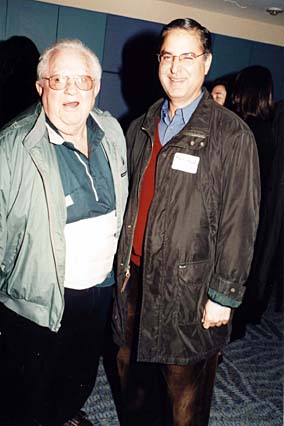 |
||||||||
| FEATURE ARTICLES | Memo Calendar | Memo Pad | Business Memo's | Loaves & Fishes | Letters | Home | ||
 |
| Hazelwood Neighborhood Association board member Gayland German (left) with fellow board member, real estate broker and Gateway Area Business Association president Fred Sanchez at recent opening of Multnomah County Children’s Receiving Center. MID-COUNTY MEMO PHOTO BY TIM CURRAN |
Planning Bureau proposes review; others pursue private agendas
LEE PERLMAN
THE MID-COUNTY MEMO
The Portland Bureau of Planning may be examining some of the Gateway Plan District’s zoning and design regulations this year to see if they suit what the city and neighborhood want to see.
Aware of the process, some private landowners are seeking some changes of their own.
The Gateway Urban Renewal District is bounded roughly by Northeast Halsey and Southeast Market Streets to the north and south, the I-205 freeway to the west, and a jagged edge extending from 106th to 113th Avenues to the east. The plan district extends as far east as the city border, and as far north in places as Northeast Weidler Street.
Within this area, planner Ellen Ryker told the Memo, the city might consider imposing stronger design regulations. Most development in this area is subject to what is known as the two-tier system. If a proposed structure is designed according to regulations called the Community Design Standards, it can be built regardless of what anyone in the city or the community thinks of it; only if the builder wants to deviate from the rules does the public have a say.
Based on the results so far, “The two-tier system doesn’t always work,” Ryker says. Instead, the city may require mandatory design review for some zones.
The bureau may also lower the allowed height and density in some areas, particularly in the east, she says. “The existing zoning could allow something that’s inappropriate for this area or even stifle development,” she says. If the allowed height and density is too high, the owner’s sale price may rise until potential developers cannot afford it, and no development takes place at all, she says.
“There’s no way that the market will support a 120-foot building here right now,” she says.
The bureau is also looking at creating “buffer zones” next to single family homes, so that the largest buildings do not loom directly over homes, she says.
It is vitally important that there be proper regulations in place in Gateway to guide future development, Ryker says. “Gateway is a very healthy commercial district,” she says. “Development is taking place here. It’s just not always the kind of development we want to see.”
Other parties heard from
Planners had hoped that the process would involve a few discreet changes that could be processed relatively quickly, not a wholesale zoning review. Unfortunately, that may not be in the cards. At least two area landowners are seeking to use it to benefit properties they own.
Auto dealer Ron Tonkin wants to eliminate from the design district regulations prohibiting outdoor vehicle storage - such as car lots - and auto maintenance. The change would apply to the area bounded by Northeast Glisan and Southeast Stark Streets, and 113th and 122nd Avenues, according to consultant and Tonkin representative Peter Fry.
Fry argues that the current regulations make any future change in Tonkin’s holdings impossible. Any change and they would lose their right to outdoor display, which would be impossible to restore. The regulations prohibit auto repair as a non-transit related use, which Fry argues is wrong. “Auto repair is the ultimate transit-related use,” he says. “When you take your car in for repair, you have no way to leave except by transit.”
At one point, Gateway Area Business Association President Fred Sanchez sought to rezone one of three residentially zoned properties he owns - one on 111th Avenue and two on 112th Avenue- for commercial use. He did not make a formal request to do this as yet but tried to work through the office of Commissioner Randy Leonard, who has been assigned the Office of Development Services.
Sanchez told the Memo that he had made the attempt on behalf of a company that wanted to put a large office there. He said Leonard’s office had been very helpful, but he had abandoned the attempt “because there wasn’t a large enough window of opportunity.” Asked why he had not sought to site his client on land already commercially zoned, he said it had been their preference and “the customer is always right.”
Sharon Owen of the Hazelwood Neighborhood Association saw it not only as a bad idea in itself, but a dangerous precedent. “It would be a new incursion into a nice straight line that delineates where the residential ends and the commercial begins. We have lots of commercial property in this district, and a lot of undeveloped land. It doesn’t make sense to have commercial development on residential land.”
MEMO Advertising | MEMO Archives | MEMO Web Neighbors | MEMO Staff | Home